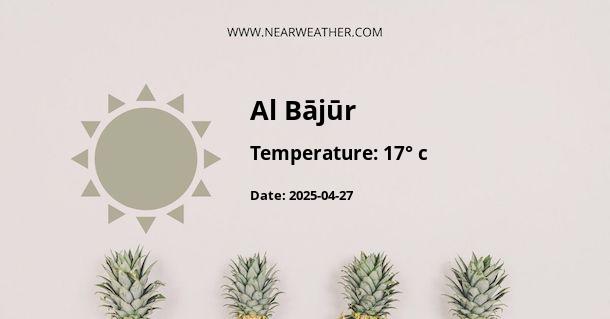The Climate and Weather in Al Bajur, Egypt
Al Bajur, located in Egypt, experiences a hot desert climate characterized by extremely high temperatures, low humidity, and minimal precipitation throughout the year. This article will provide a detailed overview of the climate and weather conditions in Al Bajur, focusing on temperature variations, rainfall patterns, and seasonal changes.
Temperature
The city of Al Bajur experiences scorching hot temperatures for the majority of the year. Summers are especially intense, with average high temperatures reaching well above 40 degrees Celsius (104 degrees Fahrenheit). The peak of summer, typically in July and August, sees temperatures soaring even higher, often exceeding 45 degrees Celsius (113 degrees Fahrenheit). The nights offer some relief, with temperatures dropping to around 25 degrees Celsius (77 degrees Fahrenheit).
Winters in Al Bajur are relatively mild compared to the scorching summers. The average high temperatures range from 18 to 24 degrees Celsius (64 to 75 degrees Fahrenheit), while the lows can drop to around 8 to 14 degrees Celsius (46 to 57 degrees Fahrenheit). January is the coldest month of the year, and frost is a rare occurrence in this desert climate.
The extreme heat during the summer months, coupled with the low humidity, can make Al Bajur feel even hotter than the recorded temperatures. It is essential for residents and visitors to take precautions, such as staying hydrated and avoiding prolonged exposure to the sun, to prevent heat-related illnesses.
Rainfall
Al Bajur experiences very limited rainfall throughout the year, as it is located in a desert region. The annual average precipitation is around 10 to 20 millimeters (0.4 to 0.8 inches), with the majority of rainfall occurring during the winter months.
The winter season, from December to February, brings the highest chance of rainfall in Al Bajur. However, even during this period, the amount of rainfall is relatively low, with most months receiving less than 5 millimeters (0.2 inches) of precipitation. March and November also see some sporadic rainfall, but the rest of the year remains mostly dry.
The scarcity of rainfall contributes to the arid nature of the region, resulting in vast stretches of desert landscapes around Al Bajur. It is crucial for agricultural activities to rely on efficient irrigation systems to sustain crops in this dry environment.
Seasonal Changes
Al Bajur experiences two distinct seasons: summer and winter. The summer season, which extends from May to September, is characterized by scorching heat and minimal rainfall. This is the peak tourist season for Egypt, as many visitors are drawn to the country's historical attractions and famous landmarks.
Winter, from November to February, offers milder temperatures and a slightly higher chance of rainfall. This season is considered more comfortable for outdoor activities and exploration of the region. The cooler weather attracts tourists seeking relief from the intense heat of the summer months.
Conclusion
Al Bajur, Egypt, experiences a hot desert climate with extremely high temperatures, low humidity, and minimal rainfall throughout the year. The scorching summers, with temperatures exceeding 40 degrees Celsius (104 degrees Fahrenheit), make heat management crucial for residents and visitors. The winters are milder, with average temperatures ranging from 18 to 24 degrees Celsius (64 to 75 degrees Fahrenheit). Precipitation is scarce, with an annual average of 10 to 20 millimeters (0.4 to 0.8 inches) of rainfall, mostly occurring during the winter months. The distinct seasons of summer and winter attract different types of tourists to Al Bajur, with summer being the peak tourist season due to the region's historical and cultural attractions.
A - Al Bājūr's Latitude is 30.430260 & Longitude is 31.036810.
A - Weather in Al Bājūr is 15° today.
A - Climate Conditions in Al Bājūr shows clear sky today.
A - Humidity in Al Bājūr is 82% today.
A - Wind speed in Al Bājūr is 7.88 km/h, flowing at 44° wind direction. today.
